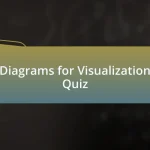Start of Mastering Units and Conversions Quiz
1. What is the relationship between kilometers and meters?
- 1 kilometer (km) = 1000 meters (m)
- 1 kilometer (km) = 10 meters (m)
- 1 kilometer (km) = 10000 meters (m)
- 1 kilometer (km) = 100 meters (m)
2. How many centimeters are in a meter?
- 100 centimeters (cm) in a meter (m)
- 0.1 centimeters (cm) in a meter (m)
- 10 centimeters (cm) in a meter (m)
- 1000 centimeters (cm) in a meter (m)
3. What is the relationship between grams and kilograms?
- 1 kilogram (kg) = 10000 grams (g)
- 1 kilogram (kg) = 10 grams (g)
- 1 kilogram (kg) = 1000 grams (g)
- 1 kilogram (kg) = 100 grams (g)
4. How many milliliters are in a liter?
- 100 milliliters (mL) in a liter (L)
- 10 milliliters (mL) in a liter (L)
- 1000 milliliters (mL) in a liter (L)
- 10000 milliliters (mL) in a liter (L)
5. What is the standard unit of length in the metric system?
- Meter (m)
- Mile (mi)
- Inch (in)
- Foot (ft)
6. How many millimeters are in a decimeter?
- 10 millimeters (mm) in a decimeter (dm)
- 1000 millimeters (mm) in a decimeter (dm)
- 1 millimeter (mm) in a decimeter (dm)
- 100 millimeters (mm) in a decimeter (dm)
7. What is the relationship between centimeters and decimeters?
- 1 decimeter (dm) = 50 centimeters (cm)
- 1 decimeter (dm) = 5 centimeters (cm)
- 1 decimeter (dm) = 100 centimeters (cm)
- 1 decimeter (dm) = 10 centimeters (cm)
8. How do you convert from liters to milliliters?
- 1 liter (L) = 1 milliliter (mL)
- 1 liter (L) = 10 milliliters (mL)
- 1 liter (L) = 1000 milliliters (mL)
- 1 liter (L) = 100 milliliters (mL)
9. What is estimation in measurement?
- An estimation is a standard unit of measurement
- An estimation is a calculation of weight
- An estimation is the exact value of a measurement
- An estimation is an approximate value of a measurement
10. Which physical quantities can be measured using standard units of measurement?
- Length, mass, and volume can be measured using standard units of measurement
- Speed, time, and force can be measured using standard units of measurement
- Distance, charge, and work can be measured using standard units of measurement
- Temperature, energy, and pressure can be measured using standard units of measurement
11. How many centimeters are in a kilometer?
- 100,000 centimeters (cm) in a kilometer (km)
- 1,000 centimeters (cm) in a kilometer (km)
- 10,000 centimeters (cm) in a kilometer (km)
- 100 centimeters (cm) in a kilometer (km)
12. What is the relationship between meters and millimeters?
- 1 meter (m) = 10000 millimeters (mm)
- 1 meter (m) = 1000 millimeters (mm)
- 1 meter (m) = 100 millimeters (mm)
- 1 meter (m) = 10 millimeters (mm)
13. What is the standard unit of mass in the metric system?
- gram (g)
- liter (L)
- ounce (oz)
- foot (ft)
14. How many liters are in a kiloliter?
- 10 liters (L) in a kiloliter (kL)
- 1000 liters (L) in a kiloliter (kL)
- 1 liter (L) in a kiloliter (kL)
- 100 liters (L) in a kiloliter (kL)
15. How do you convert from kilograms to grams?
- 1 kilogram (kg) = 10000 grams (g)
- 1 kilogram (kg) = 100 grams (g)
- 1 kilogram (kg) = 10 grams (g)
- 1 kilogram (kg) = 1000 grams (g)
16. What is the relationship between milliliters and liters?
- 1 liter (L) = 1 milliliter (mL)
- 1 liter (L) = 10 milliliters (mL)
- 1 liter (L) = 100 milliliters (mL)
- 1 liter (L) = 1000 milliliters (mL)
17. How many grams are in a tonne?
- 1,000 grams (g) in a tonne (t)
- 1,000,000 grams (g) in a tonne (t)
- 10,000 grams (g) in a tonne (t)
- 100,000 grams (g) in a tonne (t)
18. What is the relationship between decimeters and meters?
- 1 meter (m) = 10 decimeters (dm)
- 1 decimeter (dm) = 5 meters (m)
- 1 decimeter (dm) = 2 meters (m)
- 1 meter (m) = 100 decimeters (dm)
19. How many milliliters are in a kiloliter?
- 100,000 milliliters (mL) in a kiloliter (kL)
- 10,000 milliliters (mL) in a kiloliter (kL)
- 500,000 milliliters (mL) in a kiloliter (kL)
- 1,000,000 milliliters (mL) in a kiloliter (kL)
20. What is the standard unit of volume in the metric system?
- Liter
- Pound
- Gallon
- Inch
21. How do you convert from meters to centimeters?
- 1 meter (m) = 100 centimeters (cm)
- 1 meter (m) = 1000 centimeters (cm)
- 1 meter (m) = 10 centimeters (cm)
- 1 meter (m) = 10000 centimeters (cm)
22. How many grams are in a kilogram?
- 10 grams (g) in a kilogram (kg)
- 1 gram (g) in a kilogram (kg)
- 100 grams (g) in a kilogram (kg)
- 1000 grams (g) in a kilogram (kg)
23. What is the relationship between kilograms and grams?
- 1 kilogram (kg) = 100 grams (g)
- 1 kilogram (kg) = 10000 grams (g)
- 1 kilogram (kg) = 1000 grams (g)
- 1 kilogram (kg) = 10 grams (g)
24. What is the relationship between centimeters and meters?
- 1 meter (m) = 1000 centimeters (cm)
- 1 meter (m) = 100 centimeters (cm)
- 1 meter (m) = 10000 centimeters (cm)
- 1 meter (m) = 10 centimeters (cm)
25. How do you convert from centimeters to decimeters?
- Add 10
- Multiply by 10
- Subtract 10
- Divide by 10
26. What is the conversion factor between kilometers and meters?
- 1 kilometer (km) = 2000 meters (m)
- 1 kilometer (km) = 1000 meters (m)
- 1 kilometer (km) = 100 meters (m)
- 1 kilometer (km) = 500 meters (m)
27. How many centimeters are there in a meter?
- 10 centimeters (cm) in a meter (m)
- 100 centimeters (cm) in a meter (m)
- 1000 centimeters (cm) in a meter (m)
- 1 centimeter (cm) in a meter (m)
28. If one kilogram equals 1000 grams, how many grams are in 2 kilograms?
- 1500 grams
- 2500 grams
- 1000 grams
- 2000 grams
29. What is the unit of mass for measuring large quantities in the metric system?
- Stone
- Pound
- Ounce
- Tonne
30. How would you convert 5 liters into milliliters?
- 5 milliliters (mL)
- 5000 milliliters (mL)
- 500 milliliters (mL)
- 50 milliliters (mL)
Quiz Completed: Mastering Units and Conversions
Congratulations on completing the quiz on Mastering Units and Conversions! We hope you found the experience both enjoyable and enlightening. This quiz has not only tested your knowledge but has also reinforced the critical skills needed for effective problem-solving in physics. You may have learned how to accurately convert between different units, understand dimensional analysis, and appreciate the importance of precision in calculations.
Through your engagement with these questions, you’ve gained insights that will serve you well in your physics studies. Mastering these concepts is vital, as they lay the groundwork for more complex topics. Understanding units and their conversions will enable you to navigate through various physics problems with greater confidence and ease.
If you’re eager to further expand your knowledge, we invite you to explore the next section on this page. It offers additional resources and information about Mastering Units and Conversions. This content will deepen your understanding and enhance your test preparation. Keep up the great work as you continue your journey in physics!
Mastering Units and Conversions
Understanding the Importance of Units in Physics
Units provide a standard for measuring physical quantities. They enable consistent communication of scientific information. Many fundamental concepts, such as force, energy, and velocity, are defined using specific units. Understanding these units is vital for mastering physics topics. For example, Newtons measure force, while Joules measure energy. Without this understanding, students can misinterpret or miscalculate important relationships in physics.
Common Units in Physics and Their Dimensions
Physics relies on specific units for different quantities. The International System of Units (SI) includes units like meters for distance, kilograms for mass, and seconds for time. Dimensions of physical quantities typically correlate with these SI units. For instance, velocity has dimensions of length divided by time, represented as meters per second (m/s). Mastering these units aids in solving physics problems accurately.
Conversion Factors and Their Role in Problem-Solving
Conversion factors are crucial for changing units within physics calculations. A conversion factor is a ratio that expresses how many of one unit equals another. For example, 1 inch equals 2.54 centimeters. By applying conversion factors, students can easily switch between units. This skill is essential, especially in complex problems involving multiple unit systems. Accurate unit conversions are often necessary to achieve valid solutions.
Strategies for Mastering Unit Conversions in Physics
Effective strategies enhance proficiency in unit conversions. Start by memorizing key conversion factors for commonly used units. Practice dimensional analysis, which involves checking that units cancel appropriately in calculations. Solving practice problems helps reinforce these strategies. For instance, converting 20 kilometers to meters requires multiplying by 1,000. Regular practice builds confidence and accuracy in handling unit conversions.
Applying Units and Conversions in Advanced Physics Topics
Advanced physics topics often include complex unit systems. Concepts like thermodynamics and electromagnetism require a deep understanding of units. For instance, energy in thermodynamics may be expressed in calories or Joules. In electromagnetism, one must be familiar with units such as volts and amperes. Mastery of units and conversions is key to tackling advanced physics challenges. Accurate application greatly impacts the understanding of intricate concepts.
What is mastering units and conversions in physics?
Mastering units and conversions in physics refers to the skill of accurately understanding and transforming different units of measurement. This includes both SI (International System of Units) and non-SI units, such as converting between meters and kilometers or joules and calories. Accurate Unit conversion is essential for solving physics problems, as physical equations often necessitate consistent units to yield correct results. For instance, the speed of light is measured in meters per second, and using these units is crucial for calculations involving relativistic physics.
How can students improve their unit conversion skills in physics?
Students can improve their unit conversion skills by practicing conversion problems regularly and utilizing conversion factors. This involves relying on specific ratios, such as 1 inch equals 2.54 centimeters, to facilitate conversions. Additionally, studying dimensional analysis helps ensure that the units in equations match correctly. Using online tools or flashcards can also reinforce memorization of key conversions, enhancing both understanding and speed during tests.
Where can students find resources for mastering units and conversions in physics?
Students can find resources for mastering units and conversions in physics in textbooks, online educational platforms, and dedicated physics websites. Websites like Khan Academy and HyperPhysics offer tutorials and practice problems specifically focused on units and conversions. University libraries also provide access to comprehensive guides and reference materials. Moreover, many physics courses feature online resources that include practice tests and problem sets that cover unit conversions extensively.
When should students practice unit conversion for physics tests?
Students should practice unit conversion well in advance of physics tests. It is essential to start reviewing these concepts as soon as the subject material is introduced. Consistent practice should occur throughout the study period leading to the test, allowing for reinforcement and familiarity. Many tests include several questions that rely on unit conversions, making this practice crucial for achieving a good score.
Who benefits from mastering units and conversions in physics?
Students, educators, and professionals in fields such as engineering and physical sciences benefit from mastering units and conversions in physics. Mastery ensures accuracy in scientific calculations and is foundational for understanding complex topics. For instance, engineers must convert units for design specifications and safety standards, while students need it for solving problems on exams. Understanding unit conversion reduces errors and enhances comprehension in scientific pursuits.















